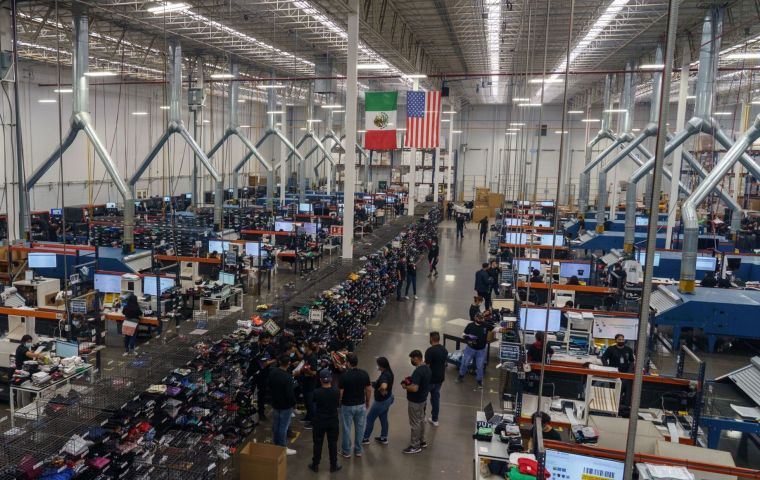MercoPress. South Atlantic News Agency
Mexico displaced China in 2023 as the US main trading partner
 Mexico still imports most of the natural gas used in industrial settings from the US. S&P Global notes that those areas are already saturated and would need more infrastructure.
Mexico still imports most of the natural gas used in industrial settings from the US. S&P Global notes that those areas are already saturated and would need more infrastructure. During 2023 Mexico became the leading sources of goods imported by the United States, displacing China for the first time in more than twenty years. According to the US Department of Commerce Mexico's resurgence signals a significant shift in global commerce dynamics.
As tensions between the US and China persist, fueled by trade disputes and tariffs, this transition to Mexico as the top US trade partner helps reduce costs and speed up the supply chain, ultimately lowering the costs of goods in the US.
Between 2022 and 2023, the value of goods imported to the US from Mexico increased by almost 5%, up to over US$ 475 billion, according to the Commerce Department. Chinese imports fell 20% in the same time period, to US$ 427.2 billion, just slightly above Canada.
Additionally, the value of Chinese imports remained above the value of Mexican imports from 2002 until this most recent data. The value of Chinese imports shot up at the start of the pandemic as many Americans purchased everything from furniture to laptops made in China. Trade with China remained strong in 2022 amid supply-chain disruptions, though values tapered off last year.
More than a third of US imports — valued over US$ 3 trillion — come from Mexico, China, and Canada.
The US trade deficit — exports minus imports — contracted by almost 19% in 2023. US businesses and consumers have been buying more from European countries, South Korea, India, and Vietnam, particularly clothing items and auto parts. Overall, US imports fell in 2023 amid declines in spending on consumer goods such as clothes and cell phones, as well as less crude oil.
Some of the decline in imported Chinese goods could be due to the Trump administration’s tariffs in 2018, which made these products more expensive for Americans. The Biden administration has continued pushing companies to “re-shore” by returning manufacturing to the US or “friend-shore” to trade with allies. Trade has fallen with China for high tariff items, while it has grown for items without tariffs, The New York Times reported.
This drop in Chinese imports may not be as severe as it seems, given that companies may import goods from other countries originally made in China to get around US tariffs.
This is all good news for Mexico. Mexico’s economy had a strong 2023, and its peso became the fastest-growing currency in the world, gaining 15% last year. The country’s stock market performed well, and Foreign Direct Investment — the amount of ownership in domestic companies being made by foreign companies or governments — was up 40%. In addition, the US avoiding a recession would be a welcome sign of relief for Mexico.
The United States-Mexico-Canada Agreement, which went into effect in 2020, replaced NAFTA and has strengthened ties between the US and its southern neighbor. However, as these relations have strengthened, tensions are starting to simmer also between the three countries.
As Mexico grows into an economic powerhouse, some American companies have accused the country of favoring local companies and limiting their ability to expand in Mexico. The US government is paying attention, and some are worried this could lead to retaliatory tariffs.
Mexico’s growing relationship with the US shows it is reaping the benefits of increased “near-shoring,” a practice in which countries bring supply chains for crucial goods to countries that are close physically and politically. This has the benefit of reducing costs and speeding up the supply chain, ultimately reducing the costs of products for consumers.
However, Mexico’s growing economy could stall if the government doesn’t invest more in the country’s infrastructure and energy availability.
Mexico still imports most of the natural gas used in industrial settings from the US. S&P Global notes that those areas are already saturated and would need more infrastructure.
Mexico also has an erratic electricity supply that is under constant strain and will be further tested as more companies move into the country. Mexico’s energy consumption has tripled in 30 years and will continue to grow, Bloomberg reported.
And then there are things Americans often take for granted, like access to water. In Nuevo León, where Tesla is building its factory, a drought in 2022 left thousands of residents without water, causing social unrest.
Mexico’s ascent as America’s top trade partner comes with more and bigger challenges that the country will need to meet to keep growing.




Top Comments
Disclaimer & comment rulesCommenting for this story is now closed.
If you have a Facebook account, become a fan and comment on our Facebook Page!